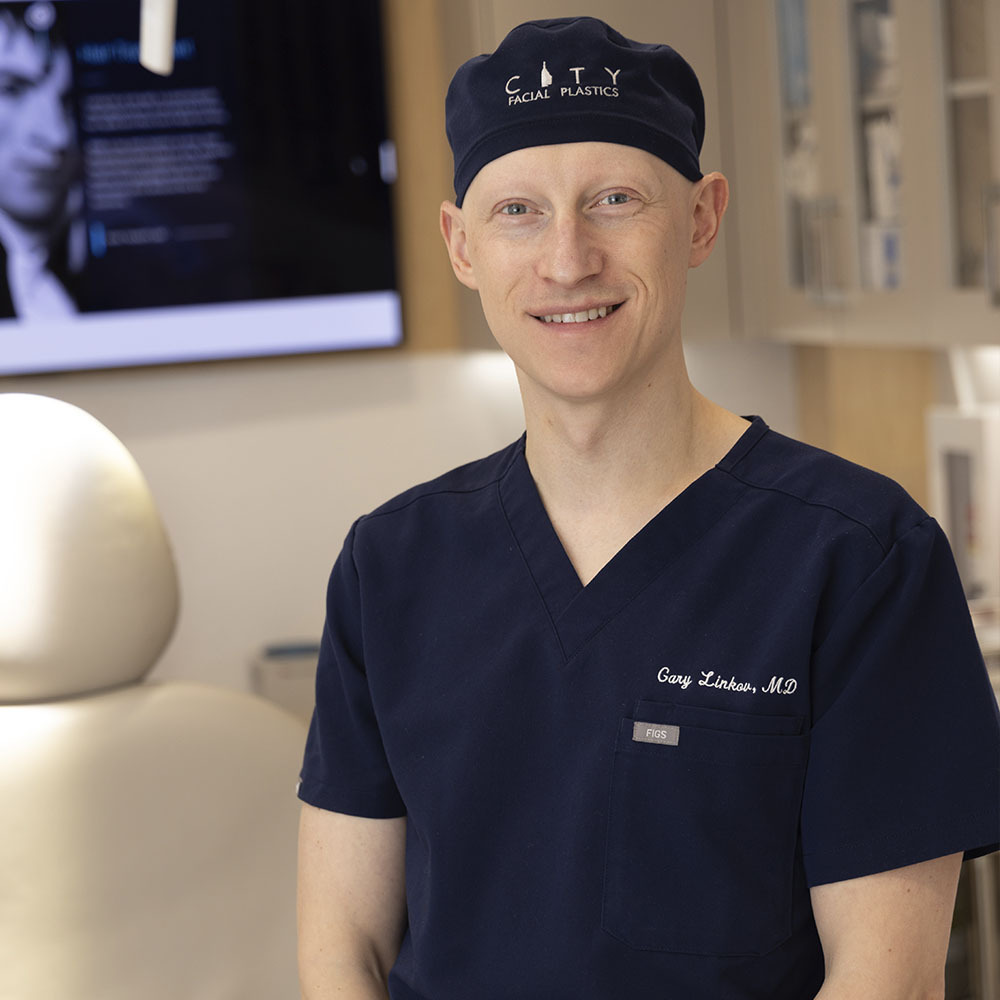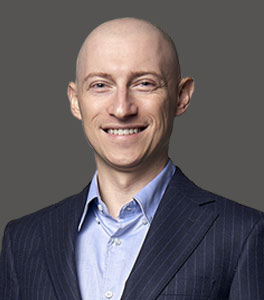


© 2025 City Facial Plastics. All Rights Reserved.
A neck lift is a cosmetic procedure that is aimed to improve the condition of muscle and skin on your neck and jawline. A facial procedure, like a facelift or rhytidectomy, can address sagging under the chin and upper neck. However, if the entire neck has sagging or aging issues, a neck lift or lower rhytidectomy, performed by the best-rated plastic surgeon in Manhattan, NY Dr. Gary Linkov, may be needed. City Facial Plastics in New York offers exceptional neck lifts to help address the emergence of a turkey waddle.


 A neck lift is a family of treatments that address problems with fat, muscle and skin on your neck and jawline. It helps to correct excess flesh on the neck and jowls and gives a contoured and youthful appearance. If there is enough elasticity in the skin, you may benefit from having liposuction (removal of excess fat) alone. Patients may also require liposuction in combination with a platysmaplasty (tightening of the muscles of the neck), to produce a sculpted, angular and youthful jawline. Patients with loose facial and neck skin often choose both a neck lift and facelift. This is in addition to or instead of liposuction.
A neck lift is a family of treatments that address problems with fat, muscle and skin on your neck and jawline. It helps to correct excess flesh on the neck and jowls and gives a contoured and youthful appearance. If there is enough elasticity in the skin, you may benefit from having liposuction (removal of excess fat) alone. Patients may also require liposuction in combination with a platysmaplasty (tightening of the muscles of the neck), to produce a sculpted, angular and youthful jawline. Patients with loose facial and neck skin often choose both a neck lift and facelift. This is in addition to or instead of liposuction.
1 month status post elelyft lip lift and deepplane facelift and necklift to improve the jawline contour, neck, and shorten the philtrum. Notice that volume has been repositioned to the lateral face due to the deepplane approach. She has received several postop Jetpeel lymphatic drainage massages to help reduce swelling.
In order to best understand neck lift surgery and what it can accomplish, it is important to be familiar with the major anatomical structures in the neck. Summarized below are the anatomical neck structures that are involved in the neck lift procedure.
The cervicomental angle is the angle between the lower aspect of the chin and the start of the neck. Research has shown that the cervicomental angle is an important part of determining attractiveness, with angles ranging 90-105 degrees considered to be most attractive and angles above this range considered to be less attractive. The hyoid bone is a bone in the upper part of the neck which helps determine the cervicomental angle.
I cannot say enough about Dr. Linkov and his staff. From the initial consult to day of surgery and post op appointments, I have had nothing but an outstanding experience. During the consult Dr. Linkov went over everything in detail and was honest compassionate throughout. I didn’t feel rushed and he answered all my questions. Leading up to the surgery, Bianca, the receptionist, was amazing. She was very responsive/professional with all my questions, and all the necessary pre-operative preparations that needed to be done. During the surgery Dr. Linkov and his team were wonderful. I felt comfortable and calm during a long surgery. Dr. Linkov followed up afterwards to make sure I was doing well. If I could give more than 5 stars I would! Highly recommend!
Mrunal Parmar
The hyoid bone is a U-shaped bone located in the anterior part of the upper neck. While its main role is to anchor the tongue, several muscles in the neck also attach to the hyoid. The hyoid bone helps with chewing, swallowing, and speech. The exact location of the hyoid bone varies from person to person, and its position helps determine the cervicomental angle.
Subcutaneous fat is the most superficial layer of fat, located just below the skin. This layer of fat is generally thin in young slim people, such that the prominence of the thyroid cartilage may be visible. As people age or gain weight, the amount of subcutaneous fat may increase.
The platysma is a broad muscle in the neck that spans from the mandible to the clavicle area. As we age, the platysma becomes weaker and thinner. The weakening of the platysma muscle causes sagging in the neck and the development of platysmal bands, which are one of the first signs of aging. It is important to note that the platysma is the continuation of the SMAS (superficial musculoaponeurotic system) which has important implications in facelift surgery.
Subplatysmal fat is the fat located deep to the platysma. This fat is located deeper in the neck than the subcutaneous fat. Subplatysmal fat is more likely than subcutaneous fat to increase over time and since it is deeper, it is more difficult to access from a procedural standpoint.
Digastric muscles are a pair of muscles in the neck that help with chewing, swallowing, and speech. The digastric muscles serve as an important landmark during neck lift surgery. Enlarged digastric muscles can give a bulging appearance to the neck, which people may find aesthetically unpleasing. Reduction in the size of the digastric muscles can be accomplished with a neck lift procedure.
Submandibular glands are glands located in the upper neck that produce saliva. The submandibular glands serve as a landmark during facelift surgery, as they are in close proximity to important nerves and arteries. Prominent submandibular glands can make the neck appear excessively full and give an irregular contour to the neck. It is possible to remove part of the submandibular glands during neck lift surgery.
There are many reasons people are interested in neck lift surgery. Most of the time, people wish to undergo this type of procedure for changes in the neck that have occurred with age. There is, however, a large number of younger people who seek out neck lift surgery because they have been unhappy with the congenital appearance of the neck. Outlined below are some common reasons people undergo a consultation for neck lift procedure.
Wrinkles, also known as rhytids, can be aesthetically unpleasing. While age is an important risk factor for wrinkle development, smoking, sun exposure, alcohol, and repetitive facial and neck movements can also contribute to wrinkle formation. “Text neck” is a term that refers to the repetitive neck motions that result from looking up and down at a cell phone, and may lead to horizontal neck wrinkles.
Will a neck lift get rid of jowls? Jowls are excess saggy tissue located just below the jawline and chin area. Jowls are part of the aging process and form due to a decrease in elasticity of collagen fibers in the skin. Jowls can be removed with a neck lift and facelift combined surgery.
Turkey neck refers to sagging of the skin, fat, and muscles of the neck. The appearance is called “turkey neck” because it resembles the red, droopy skin under the neck of a turkey. The weakening of the platysma muscle, in particular, plays a large role in the development of a turkey neck. As multiple layers of neck tissue are involved, neck lift surgery is often the best option for the management of turkey neck.
The weakening of the platysma can also contribute to the formation of platysmal bands, which are prominent, protruding vertical bands of the platysma muscle. These bands can have an unflattering appearance and are one of the first signs of aging. Neck lift surgery can decrease the appearance of platysmal bands by tightening the platysma muscle.
A double chin refers to a fullness in the neck that results in the appearance of a chin below the actual chin. Excess fat, either subcutaneous, subplatysmal, or both, is the most common cause of double chin. Laxity of the skin and muscle, as well as a jawline that is not well defined due to an individual’s underlying bony structures, can also result in a double chin. Neck lift for double chin can be very effective in making the jaw more prominent and removing excess tissue.
The answer to this question largery depends on the reasons a person desires a change in their appearance. Most people seeking neck lift surgery are in their 50’s with excess skin and fat in the neck as well as other typical signs of aging. People in their 40’s often become interested in neck lift procedure once they first notice these signs of aging.
The neck can be one of the first areas that demonstrates signs of aging. As the skin on the neck is relatively thin, it is just as susceptible to the changes of aging as the face. With all of the creams and procedures offered to enhance the youthfulness of the face, the neck can often be forgotten and thus there can be a mismatch in the appearance of the face and neck. Neck lift is one option that helps address this discrepancy.
Doing neck lift surgery early can be more effective, as the muscles are strong and the degree of lift can be more robust. There are a significant number of even younger people who desire neck lift procedure for congenital webbed neck, double chin, or other conditions resulting in an obtuse cervicomental angle.
After discussing your specific goals and desired aesthetic outcome, Dr. Linkov will outline which neck lift surgery approach would be best for you and why. Dr. Linkov can access the neck via the neck directly, via the lateral aspect of the face (facelift), or both the neck and the face.
In a neck only approach to neck lift surgery, an incision is made right under the chin to access and manipulate the underlying structures. Neck only approach to neck lift for surgery is mainly reserved for younger people, usually under 40 years old, who have fullness or heaviness in their neck but do not have the other signs of facial aging such as loose skin and jowls.
Lateral face approach to neck lift surgery is essentially performing facelift surgery and neck lift procedure at the same time. Incisions are made only in the typical areas for a facelift (in front of and behind the ears). Dr. Linkov is able to access the structures of not only the lower face but also of the neck. This approach is beneficial for people with noticeable signs of aging in both the face and the neck.
For people who desire both a facelift and neck lift surgery with very prominent signs of aging in the neck, Dr. Linkov may recommend making three general incisions: two located in the lateral face for a facelift and one located below the chin. This allows Dr. Linkov to more closely visualize and address the deep neck structures.
A mini neck lift procedure is defined differently by every surgeon. Some use it to describe a neck only approach with partial deep neck work. Others use it to indicate a small neck incision approach combined with a small lateral face approach for less invasive surgery. Rarely does a mini neck lift indicate that a complete deep neck procedure is undertaken.
For more information aboutmini neck lift procedure in NYC please call our office to schedule a consultation with the leading New York plastic surgeon Dr. Gary Linkov.
Neck lift procedure surgery is tailored to not only your desired aesthetic outcome but also how your individual anatomy contributes to your current appearance. Therefore, it is challenging to answer the question “How is neck lift done?” in a way that accurately would describe every individual’s surgery. There are, however, some generalizable concepts in discussing the steps of neck lift surgery including mini neck lift procedure. These concepts are discussed below, not necessarily in the order of which they would be performed.
The first step of neck lift surgery is identifying and making the incision. Where are neck lift scars? These scars are located where the incision is made, and their location and length depend on the type of neck lift you are having; the incision will either be below the chin, in front of and behind the ears, or both. Dr. Linkov will first draw the anticipated incision line with a marker so you can review prior to proceeding to surgery.
Once the incision is made, Dr. Linkov will visualize the subcutaneous fat. If there is excessive subcutaneous fat, it can be removed via surgical excision or liposuction. It is important not to remove too much subcutaneous fat, as the subcutaneous fat does play a role in cushioning the deeper neck structures and providing a normal skin contour to the neck.
When too much subcutaneous fat is removed, it can result in a cobra neck deformity or other skin irregularities. Cobra neck deformity refers to a hollowed appearance in the middle of the neck with looser skin on the sides.
For people with a weakened and loose platysma, the platysma can be addressed in two main ways. Parts of the platysma can be pulled together and sutured in such a way that the muscle is tightened. If the platysmal is particularly flabby, a piece of the platysma may need to be surgically removed. The remaining platysma is then sutured back together, resulting in a shortened but firm muscle. The suturing of the platysma is sometimes referred to as a “corset platysmaplasty”.
The subplatysmal fat lies deep to the platysma muscle. Since it is located deep in the neck, it can only be removed by surgical resection. It is not possible to perform liposuction on the subplatysmal fat due to the risk of damaging the deep neck structures such as blood vessels and nerves, which could lead to significant bleeding and nerve damage.
As mentioned above, some people have enlarged, or hypertrophied, digastric muscles which cause a fullness into the neck. It is often difficult, and sometimes not possible, to make this diagnosis without directly visualizing these muscles during neck surgery. If Dr. Linkov detects enlarged digastric muscles, a piece of the muscle can be removed, reducing its size and ultimately resulting in decreased neck volume.
If the submandibular glands are prominent, a piece or pieces of these glands can be removed to reduce neck fullness. The submandibular glands are close to important blood vessels and nerves, so it is important that these are removed with extreme caution and attention to detail.
Neck lift procedure can be combined with several other procedures in order to achieve your desired aesthetic outcome and provide results for the most rejuvenated and balanced appearance.
Some of the most common procedures combined with neck lift surgery include:
While neck lift surgery is more common in females, it is becoming increasingly popular among the male population. While the male neck anatomy is overall similar to female neck anatomy, it is important to note that men tend to have more prominent thyroid cartilage, which is also known as the “Adam’s apple”. When performing neck lift surgery in males, it is important to maintain the natural contour of the male neck.
While the results of neck lift are typically long-lasting, neck lift surgery is an invasive surgical procedure and does have risks. For people who desire a change in the appearance of their neck but either do not want to or are unable to undergo this type of surgery, there are several alternatives. It is important to note that these alternatives only address the superficial layers of the neck.
Kybella, also known as deoxycholic acid, is a substance that helps dissolve fat. Kybella is injected into the subcutaneous fat, destroying fat cells to ultimately reduce the volume in the neck. While Kybella can be permanent, it usually requires multiple treatments several months apart and is also expensive. There is often significant swelling for two weeks after the procedure, and the results are not predictable.
Ultherapy uses ultrasound energy to directly stimulate collagen production by changing the temperature under the skin. In doing so, it results in skin tightening. Ultherapy may be an option for skin deformities but does not adequately address the fat or other neck layers. Ultherapy results can be mixed and typically last under one year.
Coolsculpting, also known as cryolipolysis, is a procedure where a probe is placed over an area, the skin is pulled together and the temperature is reduced in such a way that the underlying fat cells are frozen and destroyed. Coolsculpting may reduce superficial fat in the neck but it does not address other signs of the aging neck such as deep fat, wrinkles, jowling, and platysmal bands.
FaceTite is a minimally invasive procedure where radiofrequency energy is used to both tighten the skin and reduce fat tissue. A needle is placed under the skin and an adjacent transponder is placed against the skin to deliver the radiofrequency energy, which helps burn the superficial fat and tighten the skin. FaceTite results are usually not permanent, typically lasting 5 years, and the procedure does not address deeper neck structures.
Neck liposuction can be performed either with a neck lift or without it. When done on its own, it typically requires one small incision made under the neck. Local anesthesia is used to numb the area. Results can be permanent but in some people, the fat can recur. As mentioned above, there is a risk of cobra neck deformity if too much fat is removed. Neck liposuction only addresses superficial fat.
Neck lift surgery is typically done under deep sedation anesthesia. With deep sedation anesthesia, intravenous medications are administered to make you sleepy and to minimize your pain during the neck lift procedure. Deep sedation is administered by a board-certified anesthesiologist in an accredited facility. Local anesthesia is also used to reduce discomfort.
Once you have chosen to get a plastic surgery neck lift, there are several steps you will need to take to prepare for surgery. These steps include:
On the day of your plastic surgery neck lift, you will first meet with an anesthesiologist to review your medical history. Before receiving anesthesia, Dr. Linkov will meet with you and draw the incision lines and review them with you in detail. You will receive an intravenous antibiotic prior to surgery to reduce the risk of infection. Once you have received the antibiotic and deep sedation, Dr. Linkov will start the surgery. Plastic surgery neck lift typically takes about 4 hours but may be longer if the surgery is complex or combined with other procedures.
Bruising and swelling after plastic surgery neck lift are common and typically improve in 1-2 weeks. You will meet with Dr. Linkov the day after your surgery and then 5-7 days after your surgery to remove your stitches and drains if they were placed. Most people return to work in 1 to 2 weeks after surgery and resume regular activities such as exercise 2 weeks after surgery. Full results are usually seen at least 3 months after surgery, once swelling mostly resolves.
Neck lift results last for many years, and sometimes can be permanent. If the deep fat is removed it rarely grows back. The partial removal of the muscle and submandibular gland also tend to be permanent. The skin of the neck, along with the face, however, will continue to loosen and sag over time, sometimes warranting a revision procedure.
Neck lift surgery is a major plastic surgery procedure with associated risks and complications, including:
Though rare, these complications can occur. It is important to closely follow your surgeon’s pre and postoperative instructions and to report anything that feels unusual.
There are patients who should not have a neck lift, these include patients with the following:
Many patients have tried less invasive modalities to improve their neck appearance and have been disappointed. Most patients are very happy after neck lift surgery that is performed by an experienced facial plastic surgeon in Manhattan, NYC such as Dr. Linkov. Since the results of neck lift procedure are much more permanent than less invasive modalities, it may be a worthy investment if you are interested in a more youthful and refreshed appearance.
There are several factors that go into determining the price of neck lift surgery. These factors include the extent of the neck lift, location of your surgeon, experience of your surgeon, type of anesthesia, anticipated length of surgery, and whether or not the neck lift is combined with other surgeries.
Dr. Gary Linkov is a board-certified facial plastic surgeon in Midtown, Manhattan. Given his extensive training in head and neck surgery, he has special expertise in the anatomy of the face and neck including the deep structures involved in neck lift surgery.
If you have ever asked yourself “how to easily find high-end neck lift near me?”, City Facial Plastics under the management of the best-rated plastic surgeon for a neck lift is always delighted to address your concerns. You can view some before and after photos from real patients who underwent neck lift surgery with Dr. Linkov below:
While the face gets the most attention when it comes to anti-aging treatments, the neck can give your age away. You may find yourself hiding your neck under clothing and accessories due to sagging skin and noticeable neckbands. With a neck lift procedure, you can feel confident wearing the clothing you prefer without hiding your neck under a scarf or turtleneck.
If you have a neck that is giving away your age, contact our team at City Facial Plastics, located in Manhattan’s Upper East Side. We will schedule your consultation with an internationally recognized facial plastic surgeon in New York City Dr. Linkov to discuss your neck lift options for improving the youthfulness of your neck.
I cannot say enough about Dr. Linkov and his staff. From the initial consult to day of surgery and post op appointments, I have had nothing but an outstanding experience. During the consult Dr. Linkov went over everything in detail and was honest compassionate throughout. I didn’t feel rushed and he answered all my questions. Leading up to the surgery, Bianca, the receptionist, was amazing. She was very responsive/professional with all my questions, and all the necessary pre-operative preparations that needed to be done. During the surgery Dr. Linkov and his team were wonderful. I felt comfortable and calm during a long surgery. Dr. Linkov followed up afterwards to make sure I was doing well. If I could give more than 5 stars I would! Highly recommend!
Mrunal Parmar

Dr. Linkov is a double board-certified by the American Academy of Facial Plastic and Reconstructive Surgery and the American Board of Otolaryngology-Head & Neck Surgery. A native of New York, Dr. Linkov graduated as a salutatorian from Cornell University and received his Medical Degree at Columbia University College of Physicians and Surgeons. Dr. Linkov conducted advanced head and neck cancer research at the world-renowned Memorial Sloan Kettering Cancer Center. Dr. Linkov is a former Adjunct Assistant Professor at New York University (NYU), where he taught Rhinoplasty.
Dr. Linkov is New York's top-rated facial plastic surgeon specializing in lip lift, facelift, rhinoplasty, and hair transplant. Voted top 5 lip lift surgeons in the US, he is listed in the prestigious SuperDoctors New York™ registry and featured on the Dr. Oz Show, where he discussed the state-of-the-art hair transplantation procedure.


City Facial Plastics 150 E 56th St, #1AB, New York, NY 10022 (212) 439-5177